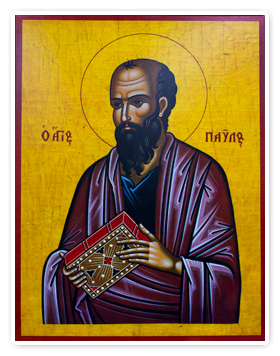

Saint Paul
June 29th
Feast of Saints Peter & Paul Patron Saints of the Patriarchate of Antioch On this day we celebrate the Feast of Saint Paul. We can learn much about the gentile Disciple from the Book of Acts and his 14 Epistles. These two mutually–independent sources confirm and complement each other, in spite of certain discrepancies of detail.
Saint Paul was born in Tarsus in Cicilia about 10 A.D. of the tribe of Benjamin, and was a Roman citizen. As a young man, he was educated in Jerusalem by Gamaliel, who gave him a thorough grounding in religious doctrine of the school of Pharisees. He became a bitter persecutor of the infant Church. But on the road to Damascus, where he was going to persecute and bring the few faithful back to present to the Jewish Court, 34 A.D., a vision of the Risen Jesus changed his whole life. The Risen Lord opened his mind to the truth of the Christian faith and revealed that He had chosen him to be the Apostle of the Pagans. From then on, Paul dedicated his life to serving Christ, Who had personally chosen him as His follower (PH.3:12).
After spending some time in Arabia, he returned to Damascus and began his preaching there. In about 39 A.D., after a brief visit to Jerusalem, he went to Syria and Cilicia, until Barnabas fetched him back to Antioch, where they preached together.
During his first missionary journey, he began to use the name, “Paul”, instead of his Jewish name, “Saul”. Fourteen years after his conversion, he went to Jerusalem to take part in the Apostle’s Council and it was partly through his influence that the Council agreed that the Jewish law was not binding on Christian converts from paganism (Acts 15).
His mission as an Apostle to the pagans was formally sanctioned. In 58, Paul was arrested in Jerusalem (Acts 21:27) and imprisoned until 60 A.D. In the autumn of 60, Festus the Procurator sent him to Rome under escort, where, after two years in prison, his case was dismissed. It is possible that he went to Spain—a subsequent imprisonment in Rome ended, according to every ancient tradition, in Martyrdom, probably in the year 67 A.D.
CHARACTER of PAUL
Saint Paul was a person of great dedication, capable of pursuing an idea with a complete disregard for the cost. For him, the only thing that mattered was God, and, as God’s servant, he refused any sort of compromise.
It was with equally single-minded determination that Paul had persecuted those he considered God’s enemies (1 Tim:13). The Apostle knew what work he had been given by God (1 Cor.9:16) and he let nothing stop him from doing it: hard work, exhaustion, suffering, poverty, danger and death. Far from letting these things weaken his love for God or Christ, he welcomed them, since they helped him to grow into the image of his suffering and crucified Master. The knowledge that his vocation was unique, gave him an enormous ambition, without making him arrogant. He never forgot that having persecuted the Church of Christ, he was the un–worthiest of all the Apostles. All of his achievements, he attributed to God’s Grace, working through Him.(1Co.15:10)
PAUL PREACHING & WRITING
His main teaching was that Christ had been crucified and had Risen from the dead and all of these were told in the Scriptures (1 Co.2:2;Ga 3:1). And what he calls “his Good News” was identical with the faith of the Apostles and the Church of his time. He emphasized the conversion of Pagans. Though he probably never met Jesus during his earthly life, Paul was familiar with His teaching (1 Th.4:15) and confidently claimed to have seen the Risen Christ, not only on the Damascus Rd. (Acts 22:17); he also had revelations and ecstasies (2 Co.12:1–4).
Within his lifetime, Saul, who became known by the Greek name, Paul (which means the sent one), made three major missionary journeys, extending from Jerusalem and Antioch of Syria, westward through Cypress and Asia Minor, into part of Europe, and finally to Rome, where he was imprisoned and died. It is important to remember that Paul’s 14 letters were not meant as theological treatises:
They were a response to questions or situations in a particular Church. They were dissertations intended for a specific circle of readers, and in a general way, for all the faithful. Paul’s letters do not give any systematic and exhaustive exposition of his teaching; they are all commentaries on certain points of sermons that he preached. The depth and range of his letters, give us all the essentials of Paul’s message. No matter what the reason was for writing, his basic teaching remained the same: That Christ died and Rose from the dead, union with Christ, and that such a union makes us members of the body of Christ (1 Cor. 12:4–20). The “union with Christ” reminds me of the story of a little girl, who was telling a teacher what Jesus meant to her.
She concluded by quoting these comforting words of the Lord: “And I give unto them eternal life, and they shall never perish, neither shall any man pluck them out of My hand” (John 10:28). Just then, jokingly, the teacher piped up with the question: “But suppose you slip through His fingers?” Quick as a flash, the little girl replied: “Never. Never. You see,I am one of the fingers.”
Troparion of Saint Paul in Tone Four Leaders of the Apostles and teachers of the world, pray to the Master of all to grant peace to the world and great mercy to our souls.






